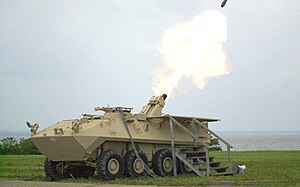Dragon Fire (mortar)
| Dragon Fire II mortar system | |
|---|---|

Test firing at the Naval Surface Warfare Center.
|
|
| Type | Heavy Mortar |
| Place of origin | United States |
| Specifications | |
| Shell | ? |
| Caliber | 120 mm |
| Rate of fire | 10 rounds per minute (maximum) 4 rounds per minute (sustained) |
| Effective firing range | 8,200 m (13,000 m with rocket assisted projectile) |
The Dragon Fire 120 mm heavy mortar was designed and produced by the French company TDA Armaments that was picked up by the US Marine Corps for its EFSS (Expeditionary Fire Support System) requirement. It is a fully automated mortar capable of using rifled or smoothbore 120 mm ammunition. Like all mortars, it is a high-angle-of-fire weapon used for indirect fire support. Dragon Fire is also expected to be effective in a counter-battery role.
The US Marine Corps Warfighting Laboratory (MCWL) started a Concept Demonstrator project in 1997. They wanted a weapon that would be a "mortar in a box," that is a weapon that could be remotely emplaced and fired unattended on a future battlefield. In late 1997, MCWL accepted a proposal by the army's Program Manager, Mortars (PM Mortars) and Armament Research, Development, and Engineering Command (ARDEC) at Picatinny Arsenal, New Jersey to design and build a firing system to fulfill the design objectives. An early requirement was that the system had to be a 120mm system to give sufficient lethality and range. Ultimately, the design team picked parts of the French Thomson-Daimler Armements (TDA) experimental 2R2M mortar because it had a usable power driven traverse and elevation in addition to a loading system. Its 120mm rifled ammunition promised greater accuracy and range.
The project completed the experimental weapon, now called the Dragon Fire, in 17 months. It was used in a series of firing experiments beginning in September 1998. During 1999-2002, the Dragon Fire was used during the Limited Object Experiment (LOE) Urban Warrior and several follow-on experiments, and the French-made 2R2M mortar mounted in a Piranha vehicle served as a surrogate for a mobile, Light Armored Vehicle-mounted firing system. These experiments showed that the concept of automating the fire control, aiming and loading of a medium-range firing system substantially reduced fire mission response times and resulted in accurate, efficient fire.
...
Wikipedia
